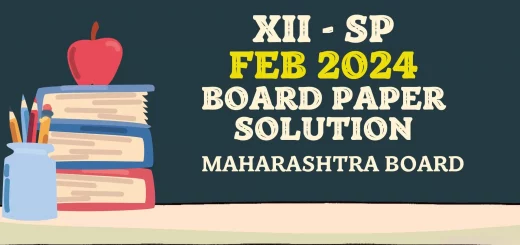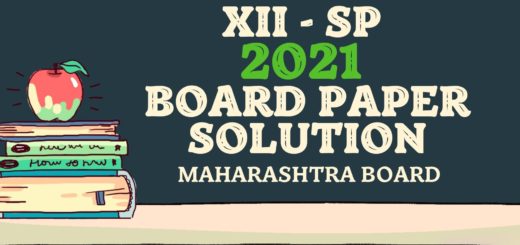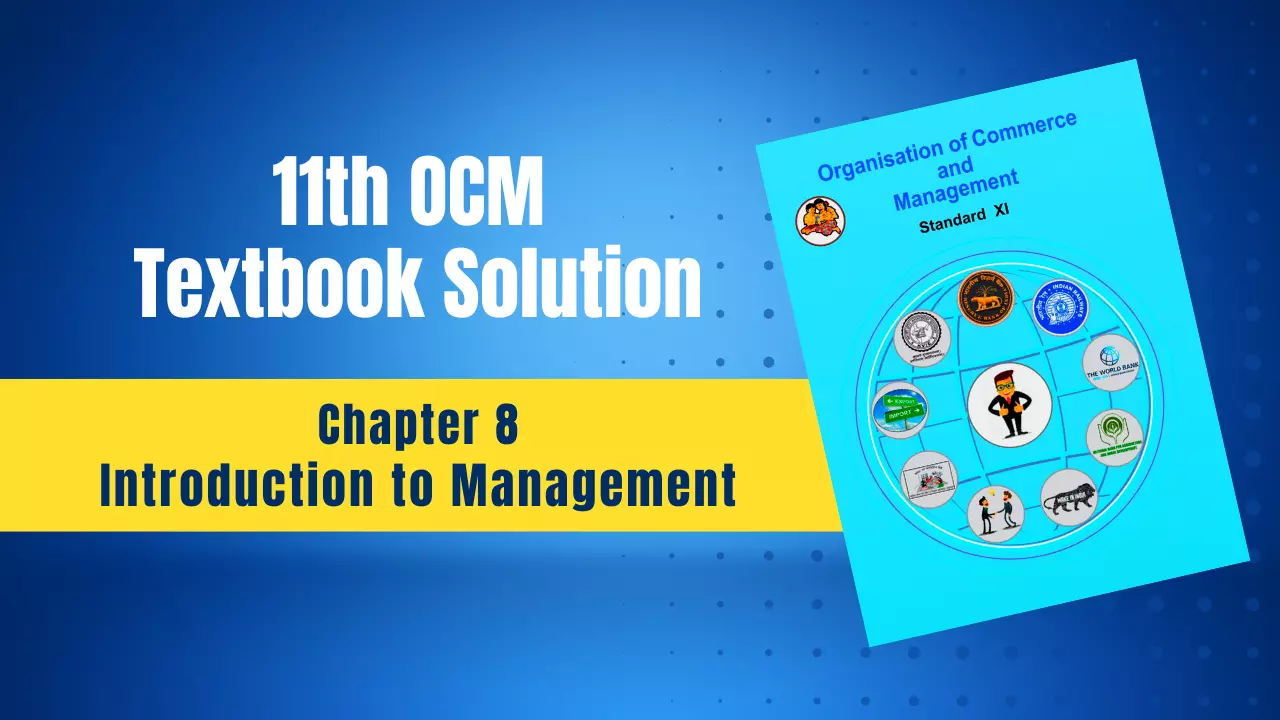HSC Economics Question Paper Solution 2024 | Maharashtra Board (Download Free PDF)
Table of Contents
HSC Economics Question Paper Solution 2024
- 12th Commerce July 2022 Question Papers
- 12th Commerce March 2021 Question Papers
- 12th Commerce March 2022 Question Papers
- 12th Commerce March 2023 Question Papers
- 12th Commerce July 2023 Question Papers
- 12th Commerce Feb 2024 Question Papers
- 12th Commerce Feb 2025 Question Papers

HSC Economics Question Paper Solution 2024
Q. 1. (A) Choose the correct option : (5) {20}
1) Method adopted in microeconomics analysis.
i) Lumping method
ii) Aggregative method
iii) Slicing method
iv) Inclusive method
Options :
a) i, iii, iv
b) ii, iii, iv
c) Only iii
d) Only i
2) Factors which are working in unorganized money market.
i) Money lenders
ii) Commercial bank
iii) Hundi
iv) Chit funds
Options :
a) i, ii, iii
b) ii, iii
c) ii, iv
d) i, iii, iv
3) Optional functions of Government.
i) Protection from external attack
ii) Provision of education and health services
iii) Provision of social security measures
iv) Collection of tax
Options :
a) ii, iii
b) i, ii, iii
c) ii, iii, iv
d) All of the above
4) Statements that highlight the significance of index numbers.
i) Index numbers are useful for making future predictions.
ii) Index numbers help in the measurement of inflation.
iii) Index numbers help to frame suitable policies.
iv) Index numbers can be misused.
Options :
a) ii, iii, iv
b) i, ii, iii
c) i, ii, iv
d) i, iii, iv
5) Blood bank is an example of _______.
i) Place utility
ii) Knowledge utility
iii) Service utility
iv) Time utility
Options :
a) i, ii, iii
b) ii, iii, iv
c) i, ii, iv
d) Only iv
(B) Find the odd word out: (5)
i) Types of demand :
Direct demand, Indirect demand, Composite demand, Market demand.
ii) Features of National Income :
Financial year, Money value, Static concept, Flow concept.
iii) Types of budget :
Deficit budget, Zero budget, Balanced budget, Surplus budget.
iv) Legal monopoly :
Patent, OPEC, Copyright, Trademark.
v) Financial Assets :
Bonds, Land, Govt. Securities, Derivatives.
(C) Give an economic term: (5)
i) More quantity is demanded due to changes in the favourable factors determining demand other than price. (Expansion of Demand)
ii) Deposits that are withdrawable on demand. (Demand Deposit)
iii) Charging different prices to different consumers for the same product or services. (Price Discrimination)
iv) Net addition made to total cost by producing one more unit of output. (Marginal Cost)
v) Degree of responsiveness of quantity demanded to change in income only. (Income Elasticity of Demand)
(D) Complete the correlation: (5)
i) General equilibrium : Macro Economics : : Partial equilibrium : Micro Economics
ii) Output method : Product Method : : Income method : Factor cost method
iii) Form utility : Furniture : : Knowledge utility : Doctor
iv) Perfectly elastic demand : Ed = ∞ : : Perfectly elastic demand : Ed = 0
v) Price constant : Change in supply : : Other factors constant : Variation of supply.
Q. 2. (A) Identify and explain the following concepts : (Any 3) (6) [12]
(i) Manisha satisfied her want of writing an essay by using pen and notebook.
Identified Concept: Utility
Explanation: Utility refers to the capacity of a commodity to satisfy a human want.
(ii) Raghu’s father invested his money in a market for long term funds both equity and debt raised within and outside the country.
Identified Concept: Capital Market
Explanation: A capital market is a market for long-term funds both equity and debt raised within and outside the country.
(iii) Due to mandatory use of masks during corona epidemic, the demand for mask producing labour has increased.
Identified Concept: Indirect Demand
Explanation: It refers to demand for goods that are needed for further production.
(iv) Maharashtra purchased wheat from Punjab.
Identified Concept: Internal/Home Trade.
Explanation: The buying and selling of goods and services within the boundaries of a nation are referred to as ‘Internal Trade’ or ‘Domestic Trade’ or ‘Home Trade’.
(v) Jagruti receives a monthly pension of Rs 5,000 from the state government.
Identified Concept: Transfer Income
Explanation: Transfer income refers to the income received without rendering any productive service in return.
Q. 2. (B) Distinguish between (Any 3) (6)
(i) Recurring deposits and Fixed deposits.
| Recurring deposits | Fixed deposits |
| Recurring deposit refers to a deposit wherein a customer deposits a fixed amount at regular intervals for a specified period of time. | Fixed deposits refer to a lumpsum amount deposited by a customer for a specified period of time. |
| The rate of interest is higher which is similar to a fixed deposit account. | The rate of interest is higher as compared to other deposits. |
(ii) Total utility and Marginal utility.
| Total Utility | Marginal Utility |
| It is an aggregate of utilities from all successive units of a commodity consumed. | It is the addition made by the last unit of a commodity consumed. |
| In normal cases, the numerical value of total utility is always positive. | The numerical value of marginal utility can be positive, zero, or negative. |
(iii) Perfectly Elastic Demand and Perfectly Inelastic Demand.
| Perfectly Elastic Demand. | Perfectly Inelastic Demand. |
| When a slight or zero change in the price brings about an infinite change in the quantity demanded of that commodity, it is called perfectly elastic demand. | When a percentage change in price has no effect on the quantity demanded of a commodity it is called perfectly inelastic demand. |
| The numerical value of the elasticity of demand is zero. | The numerical value of elasticity of demand is zero. |
(iv) Price Index and Quantity Index.
| Price Index | Quantity Index |
| It measures the general changes in the prices of goods. It compares the level of prices between two different time periods. | It is also called volume index number. It measures changes in the level of output or physical volume of production in the economy. |
| P01 = Σp1 / Σp0 × 100 | Q01 = Σq1 / q0 × 100 |
(v) Internal Debt and External Debt.
| Internal Debt | External Debt |
| When a government borrows from its citizens, banks, central bank, financial institutions, business houses, etc., within the country, it is known as internal debt. | When a government borrows from foreign governments, foreign banks or institutions, international organizations like International Monetary Fund, World Bank etc., it is known as external debt. |
| Use of domestic currency | Use of foreign currency |
| Internal debt is less complex for management. | External debt is more complex for management. |
Q. 3. Answer the following : (Any 3) (12)
i) Explain any four types of demand.
Answer:
Types of Demand
1) Direct demand: It is the demand by the consumer for goods that satisfy their wants directly. They serve the direct consumption needs of the consumers. Thus, it is the demand for consumer goods. For example, demand for cloth, sugar, etc.
2) Indirect demand: Indirect demand is also known as derived demand. It refers to the demand for goods that are needed for further production. It is the demand for producer’s goods. Hence, all factors of production have indirect or derived demand. For example, demand for workers in a sugar factory is derived or indirect demand.
3) Complementary/Joint demand: When two or more goods are demanded jointly to satisfy a single want, it is known as joint or complementary demand. For example, car and fuel, etc.
4) Composite demand: The demand for a commodity that can be put to several uses is known as composite demand. For example, electricity is demanded for several uses such as light, fan, washing machine, etc.
5) Competitive demand: It is demand for those goods which are substitutes for each other. For example, tea or coffee, sugar or jaggery, etc.
(ii) Explain any four problems of capital market in India.
Answer: The following points explain the problems faced by the Indian Capital Market
1) Financial Scams:
An increasing number of financial frauds have resulted in irreparable loss for the capital market. Besides this, it has also led to public distrust and loss of confidence among individual investors.
2) Insider trading and price manipulation:
Insider trading means buying or selling of a security by someone who has access to non-public information or ‘unpublished information’ for personal benefit. Price manipulation or price rigging, on the other hand, means simply raising the prices of shares through buying and selling of shares by certain individuals for personal gains.
3) Inadequate debt instruments:
Debt instruments include bonds, debentures, etc. There is not much trading in the debt securities due to narrow investor base, high cost of issuance, and lack of accessibility to small and medium enterprises.
4) Decline in the volume of trade:
Regional stock exchanges have witnessed a sharp decline in the volume of trade because investors prefer to trade in securities listed in premier stock exchanges like BSE, NSE etc.
(iii) Explain any four features of utility.
Answer:
Utility: Utility is the capacity of a commodity to satisfy human wants. In other words, utility is the want satisfying power of a good.
The following are the features of utility:
1) Relative concept:
Utility is related to time and place. It varies from time to time and place to place. For example, (i) woollen clothes have a greater utility in the winter. (ii) Sand has greater utility at the construction site than at the seashore.
2) Subjective concept:
It is a psychological concept. Utility differs from person to person. This is due to differences in taste, preferences, likes, dislikes, nature, habits, profession, etc. For example, a stethoscope has utility to a doctor but not to a layman.
3) Ethically neutral concept:
The concept of utility has no ethical consideration. It is a morally colourless concept. The commodity should satisfy any want of a person without consideration of what is good or bad, desirable or undesirable. For example, a knife has utility to cut fruits and vegetables as well as it can be used to harm someone. Both wants are of different nature but are satisfied by the same commodity. Thus, utility is ethically neutral.
4) Utility differs from usefulness:
Utility is the capacity of a commodity to satisfy human wants, whereas usefulness indicates value in use of the commodity. For example, milk has both utility as well as usefulness to a consumer, while liquor has utility only to an addict, but has no usefulness.
5) Utility differs from pleasure:
A commodity may possess utility but it may not give any pleasure to the consumer. For example, injection for a patient has utility because it cures the ailment but it hardly gives any enjoyment or pleasure to him.
(iv) Explain any four reasons for the growth of public expenditure.
Answer: It is observed that there is a continuous growth in public expenditure in a developing country like India.
The following are some of the important reasons :
1) Increase in the Activities of the Government:
The modern government performs many functions such as the spread of education, public health, public works, public recreation, social welfare schemes, etc. It is observed that new functions are continuously being undertaken and old functions are being performed more efficiently on a large scale by the government. This leads to an increase in public expenditure.
2) Rapid Increase in Population:
The population of developing countries like India is increasing fast. In the 2011 Census, it was 121.02 crores. As a result, the government has to incur greater expenditure to fulfil the needs of the increasing population.
3) Growing Urbanization:
The spread of urbanization is a global phenomenon of the day. This leads to an increase in the government expenditure on water supply, roads, energy, schools and colleges, public transport, sanitation, etc.
4) Increasing Defence Expenditure:
In modern times, defence expenditure of the government is increasing even in peacetime due to unstable and hostile international relationships.
5) Spread of Democracy:
The majority of the countries in the world are democratic in nature. A democratic form of government is expensive due to regular elections and other such activities. This results in an increase in the total expenditure of the government.
v) Explain any four features of macroeconomics.
Answer:
Macroeconomics is the branch of economics that analyses the entire economy. It deals with the total employment, national income, national output, total investment, total consumption, total savings, general price level, interest rates, inflation, trade cycles, business fluctuations, etc. Thus, macroeconomics is the study of aggregates.
The following are the features of macroeconomics.
i) Study of Aggregates
Macroeconomics deals with the study of economy as a whole. It is concerned with aggregate concepts such as national income, national output, national employment, general price level, business cycles, etc.
ii) Income Theory
Macroeconomics studies the concept of national income, its different elements, methods of measurement, and social accounting. Macroeconomics deals with aggregate demand and aggregate supply. It explains the causes of fluctuations in the national income that lead to business cycles, i.e. inflation and deflation.
iii) General Equilibrium Analysis
Macroeconomics deals with the behaviour of large aggregates and their functional relationship. General Equilibrium deals with the behaviour of demand, supply, and prices in the whole economy.
iv) Interdependence
The macro analysis takes into account interdependence between aggregate economic variables, such as income, output, employment, investments, price level etc. For example, changes in the level of investment will finally result into changes in the levels of income, levels of output, employment, and eventually the level of economic growth.
v) Lumping Method
The lumping method is the study of the whole economy rather than its parts. According to Prof. Boulding, “A Forest is an aggregation of trees, but it does not reveal the properties of an individual tree.”
This reveals the difference between microeconomics and macroeconomics.
Solution of other subjects
Solution of all Chapters of Economics
1 – 2 – 3A – 3B – 4 – 5 – 6 – 7 – 8 – 9 – 10
Q. 4. State with reasons whether you agree or disagree with the following statements (Any 3) (12)
(i) Over the last 75 years, India’s foreign trade has undergone a complete change in terms of composition and direction.
Answer: Yes, I agree with this statement.
Reason:
(ii) Macroeconomics is different from Microeconomics.
Ans: Yes, I agree with this statement.
Reason: a) Macroeconomics is the study of entire economy. On the other hand, microeconomics is the study of a particular segment of an economy.
b) Macroeconomics studies aggregate demand, aggregate supply, national income, employment, etc. While microeconomics studies individual units such as individual demand, individual supply, and Price determination of product.
c) Macroeconomics follows general equilibrium analysis. While microeconomics follows partial equilibrium analysis.
d) Macroeconomics uses a lumping method. On the other hand, microeconomics uses the slicing method.
Therefore, Macroeconomics is different from microeconomics.
(iii) Price maker is the only feature of monopoly market.
Answer: Yes, I agree with this statement.
Reason:
(iv) There are many sources of non-tax revenue.
Ans: No, I disagree with this statement.
Reason:
(v) There are many types of index numbers.
Answer: No, I disagree with this statement.
Reason:
Q. 5. Study the following table, figure, and passage and answer the questions given below it (Any 2): (8)
(i) Observe the following table and answer the questions given below it:
| Commodities | Price in 2006 (in Rs) (Base Year) P0 | Price in 2019 (in Rs) (Current Year) P1 |
| A | 20 | 30 |
| B | 30 | 45 |
| C | 40 | 60 |
| D | 50 | 75 |
| E | 60 | 90 |
Questions:
- Write the formula for calculation of price index. (1)
- Find the value of ΣP0 and ΣP1. (1)
- Find the price index P01. (2)
(ii) Observe the given diagram and answer the following questions:
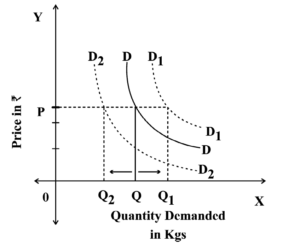
- Rightward shift in demand curve __________ (1)
- Leftward shift in demand curve ____________ (1)
- Price remains ___________ (1)
- Increase and decrease in demand comes under _________ (1)
(iii)
In common language, the term market means a specific place where buyers and sellers of a commodity meet and exchange their goods. But in Economics, it is not necessarily a place, but it is an arrangement through which buyers and sellers come in contact with each other directly or indirectly, and exchange of goods takes place among them.
The market can be classified based on place, time and competition. Market on the basis of competition is perfect competition and imperfect competition. Perfect competition is an imaginary concept of market, and in reality, we observe various types of imperfect competition like monopoly, duopoly, oligopoly and monopolistic competition.
In practice, monopolistic competition is used. In this market, there are some features of perfect competition and monopoly acting together. The uniqueness of this market lies in the fact that a difference is made between cost of production and selling cost. Selling cost refers to the cost incurred by the firm to create more demand for its product and increase the volume of sales. It includes expenditure on advertisements, hoardings, window displays etc.
(1) Explain the concept of Market from Economic sense. (1)
Answer:
(2) Write the classification of Market. (1)
Answer:
(3) Write your own opinion about selling cost. (2)
Q. 6. Answer the following questions in detail: (Any 2) (16)
i) Explain the concept of price elasticity with its types.
Answer:
Price elasticity: According to Prof. Alfred Marshall, price elasticity of demand is a ratio of proportionate change in the quantity demanded of a commodity to a given proportionate change in its price only.
Ed = Percentage change in Quantity Demanded/Percentage change in Price
Symbolically,
Ed = %∆Q / %∆P ,
Ed = ∆Q/Q ÷ ∆P/P
Ed = ∆Q/Q × P/∆P
Where,
Q = Original quantity demanded
∆Q = Difference between the new quantity and original quantity demanded
P = Original price
∆P = Difference between new price and original price
The following are the types of Price Elasticity of Demand:
1) Perfectly Elastic Demand (Ed = ∞) :
When a slight or zero change in the price brings about an infinite change in the quantity demanded of that commodity, it is called perfectly elastic demand. It is only a theoretical concept. For example, a 10% fall in price may lead to an infinite rise in demand.
Ed = Percentage change in Quantity Demanded / Percentage change in Price = ∞
Ed = ∞
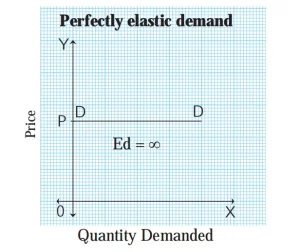
In the above figure, the demand curve DD is a horizontal line parallel to the X-axis, indicating perfectly elastic demand.
2) Perfectly inelastic demand (Ed = 0) :
When a percentage change in price has no effect on the quantity demanded of a commodity, it is called perfectly inelastic demand. For example, a 20% fall in price will have no effect on the quantity demanded.
Ed = %∆Q / %∆P
Ed = 0/20 = 0
Ed = 0
In practice, such a situation rarely occurs. For example, the demand for salt and milk.
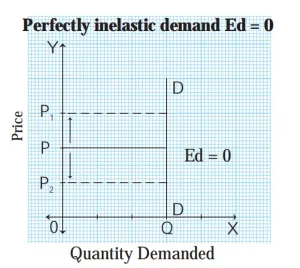
In the above figure, when price rises from OP to OP1 or when the price falls from OP to OP2, demand remains unchanged at OQ. Therefore, the demand curve is a vertical straight line parallel to the Y axis, indicating perfectly inelastic demand.
3) Unitary elastic demand (Ed = 1) :
When a percentage change in price leads to a proportionate change in quantity demanded, then demand is said to be unitary elastic. For example, a 50% fall in price of a commodity leads to 50% rise in quantity demanded.
Ed = %∆Q / %∆P
Ed = 50/50 = 1
∴ Ed = 1
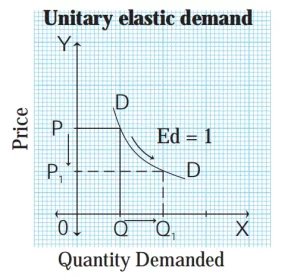
In the above figure, when price falls from OP to OP1 (50%), demand rises from OQ to OQ1 (50%). Therefore, the slope of the demand curve is a ‘rectangular hyperbola’.
4) Relatively elastic demand (Ed >1) :
When a percentage change in price leads to more than proportionate change in quantity demanded, the demand is said to be relatively elastic. For example, 50% fall in price leads to 100% rise in quantity demanded.
Ed = %Q / %P
Ed = 100/50
∴Ed = 2
Ed > 1
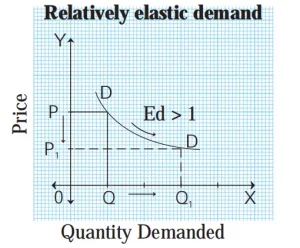
In the above figure, when price falls from OP to OP1 (50%), demand rises from OQ to OQ1 (100%). Therefore, the demand curve has a flatter slope.
5) Relatively inelastic demand (Ed < 1) :
When a percentage change in price leads to less than proportionate change in the quantity demanded, demand is said to be relatively inelastic. For example, 50% fall in price leads to 25% rise in quantity demanded.
Ed = %∆Q / %∆P = 25/50 = 0.5
Ed = 0.5
∴Ed < 1

In the above figure, when price falls from OP to OP1 (50%), demand rises from OQ to OQ1 (25%). Therefore, the demand curve has a steeper slope.
ii) Explain the concept of National income and explain the practical difficulties involved in the measurement of National income.
Answer:
The modern economy is a money economy. Hence, the National Income of a country is expressed in terms of money. The total income of the nation is called National Income.
In real terms, national income is the flow of goods and services produced in an economy during a year.
According to NIC “A national estimate measures the volume of commodities and services turned out during a given period counted without duplication.”
Theoretical Difficulties or Conceptual Difficulties: In practice, a number of difficulties arise in the collection of statistical data required for estimation of national income. Some of the practical difficulties are as follows:
1) Problem of double counting:
The greatest difficulty in calculating national income is of double counting. It arises from the failure to distinguish properly, between a final and an intermediate product. For example, flour used by a bakery is an intermediate product and that by a household is final product.
2) Existence of non-monetized sector:
In India, especially in rural areas, there exists the non-monetized sector. Agriculture, still being in the nature of subsistence farming, a major part of production is partly exchanged for other goods and services. It is excluded while counting national income.
3) Inadequate and unreliable data:
Adequate and correct data on production and cost data relating to crops, fisheries, animal husbandry, forestry, construction workers, small enterprises etc., are not available in a developing country. Besides this, data on unearned incomes, consumption and investment expenditure of rural and urban population are also not available. This does not reveal the actual size of national income.
4) Depreciation:
Depreciation refers to wear and tear of capital assets, due to their use in the process of production. There are no uniform, common or accepted standard rates of depreciation applicable to the various capital assets. Thus, it is difficult to make correct deductions for depreciation.
5) Capital gains or losses:
Capital gains or capital losses, which accrue to the property owners by increase or decrease in the market value of their capital assets or changes in demand, are not included in the national income because these changes do not result from current economic activities.
6) Illiteracy and ignorance:
Due to ignorance and illiteracy, small producers do not keep an account of their production. So they cannot give information about the quantity or value of their output.
7) Difficulties in the classification of working population:
In India, working population is not clearly defined. For instance, farmers in India are not engaged in agriculture around the year. Obviously, in the off-season, they engage themselves in alternative occupations. In such a case, it is very difficult to identify their income from a particular occupation.
8) Valuation of inventories:
Raw materials, intermediate goods, semi-finished and finished products in the stock of the producers are known as inventories. Any mistake in measuring the value of inventory will distort the value of the final production of the producer. Therefore, the valuation of inventories requires careful assessment.
iii) State and explain the law of supply with assumptions.
Answer:
Law of Supply
Introduction :
The law of supply is also a fundamental principle of economic theory like law of demand. It was introduced by Prof. Alfred Marshall in his book, ‘Principles of Economics’ which was published in 1890. The law explains the functional relationship between price and quantity supplied.
Statement of the Law :
“Other things being constant, higher the price of a commodity, more is the quantity supplied and lower the price of a commodity less is the quantity supplied”
In simple words, “other factors remaining constant, a rise in price results in a rise in the quantity supplied and vice versa. Thus, there is a direct relationship between price and quantity supplied.
Symbolically,
Sx = f (Px)
S = Supply
x = Commodity
f = Function
P = Price of commodity
The law of supply is explained with the help of the following schedule and diagram
| Price of commodity x (in ₹) | Supply of commodity x (in kgs.) |
| 10 | 100 |
| 20 | 200 |
| 30 | 300 |
| 40 | 400 |
| 50 | 500 |
The above table explains the direct relationship between price and quantity of commodity supplied. When price rises from ₹10 to ₹20, ₹30, ₹40 and ₹50, the supply also rises from 100 to 200, 300, 400 and 500 units respectively.
It means, when price rises supply also rises and when price falls supply also falls. Thus, there is direct relationship between price and quantity supplied which is shown in following figure:
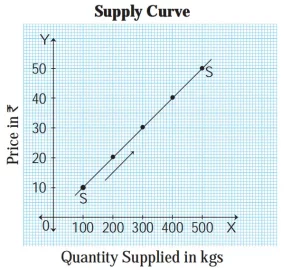
In the above figure, X axis represents quantity supplied and Y axis represents the price of the commodity. Supply curve ‘SS’ slopes upwards from left to right which has a positive slope. It indicates a direct relationship between price and quantity supplied.
Assumptions of the law :
The law of supply is based on the following assumptions :
1) Constant cost of production :
It is assumed that there is no change in the cost of production. A change in cost of production will affect the profits of the seller. Therefore, less quantity will be supplied at the same price.
2) Constant technique of production :
It is also assumed that technique of production does not change. Improved technique of production may lead to an increase in production. This in turn may lead to an increase in the supply at the same price.
3) No change in weather conditions :
It is assumed that there is no change in the weather conditions. Natural calamities like floods, earthquakes etc. may decrease supply.
4) No change in Government policy :
It is also assumed that government policies like taxation policy, trade policy etc. remain unchanged.
5) No change in transport cost :
It is assumed that there is no change in the condition of transport facilities and transport cost. For example, better transport facility increases supply at the same price.
6) Prices of other goods remain constant :
Prices of other goods are assumed to remain constant. If they change, the law of supply may not hold true because producer may transfer resources to other products.
7) No future expectations :
The law also assumes that the sellers do not expect future changes in the price of the product.
Solution of other subjects
Solution of all Chapters of Economics
1 – 2 – 3A – 3B – 4 – 5 – 6 – 7 – 8 – 9 – 10
Check out other posts related to the 12th Commerce
How to write an OCM paper for the board Exam.
